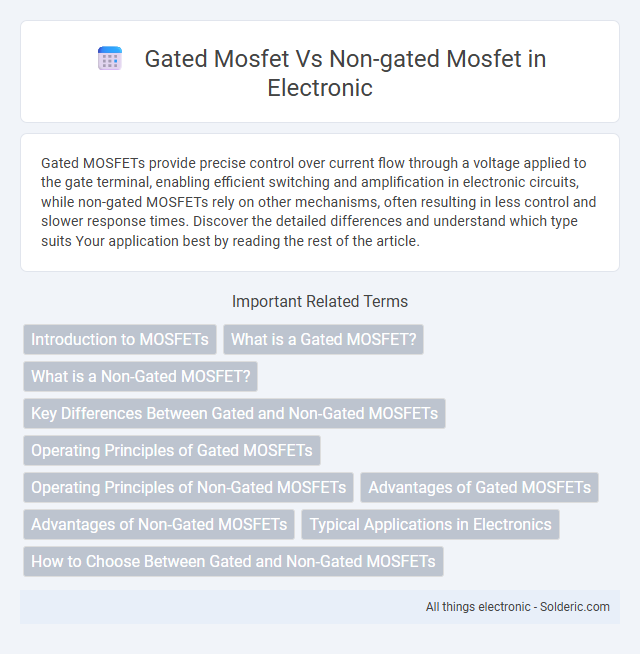Gated MOSFETs provide precise control over current flow through a voltage applied to the gate terminal, enabling efficient switching and amplification in electronic circuits, while non-gated MOSFETs rely on other mechanisms, often resulting in less control and slower response times. Discover the detailed differences and understand which type suits Your application best by reading the rest of the article.
Comparison Table
| Feature | Gated MOSFET | Non-Gated MOSFET |
|---|---|---|
| Gate Control | Present, controls channel conductivity | Absent, no gate terminal |
| Switching Capability | High-speed switching | Limited or no switching function |
| Applications | Switches, amplifiers, digital circuits | Basic resistive or diode-like applications |
| Operation Principle | Voltage-controlled resistor | Current or voltage uncontrolled conduction |
| Symbol | Three terminals: Gate, Drain, Source | Two terminals: Drain and Source |
| Power Efficiency | Higher due to gate control | Lower due to lack of gate control |
Introduction to MOSFETs
MOSFETs (Metal-Oxide-Semiconductor Field-Effect Transistors) serve as essential components in modern electronics, enabling efficient switching and amplification. Gated MOSFETs incorporate a gate terminal that controls the conductivity channel between the source and drain, offering precise voltage-controlled operation. Non-gated MOSFETs lack this control gate, resulting in limited switching capabilities and reduced efficiency compared to their gated counterparts.
What is a Gated MOSFET?
A Gated MOSFET, also known as a Metal-Oxide-Semiconductor Field-Effect Transistor with a gate terminal, controls the flow of current between the source and drain terminals by applying voltage to the gate. This gate voltage modulates the conductivity of a semiconductor channel, enabling precise switching and amplification in electronic circuits. Unlike non-gated devices, the gated MOSFET offers high input impedance and low power consumption, making it essential in modern digital and analog applications.
What is a Non-Gated MOSFET?
A Non-Gated MOSFET, often referred to as a MOSFET without a conventional gate terminal, operates based on the intrinsic electric field formed between the source and drain, rather than an externally controlled gate voltage. Unlike gated MOSFETs, which allow precise control of current flow through the application of gate voltage, non-gated MOSFETs rely on material properties and doping profiles to influence conduction. Your choice between these devices depends on the required control, switching speed, and application-specific performance criteria.
Key Differences Between Gated and Non-Gated MOSFETs
Gated MOSFETs feature an insulated gate terminal that controls electron flow, enabling precise switching and amplification, while non-gated MOSFETs lack this control, operating more like traditional resistors. Key differences include gated MOSFETs having high input impedance and lower power consumption due to voltage-driven operation, whereas non-gated MOSFETs rely on current flow, leading to higher losses. Your circuit design benefits from gated MOSFETs when efficient switching and signal control are critical.
Operating Principles of Gated MOSFETs
Gated MOSFETs operate by using an insulated gate terminal to control the conductivity of a semiconductor channel between source and drain terminals, enabling efficient switching and amplification. The gate voltage modulates the electric field in the channel region, altering the charge carrier concentration and thus the device's conductivity. This field-effect control mechanism distinguishes gated MOSFETs from non-gated variants, where such precise electrical control is not present.
Operating Principles of Non-Gated MOSFETs
Non-gated MOSFETs, often referred to as junction field-effect transistors (JFETs), operate by using a reverse-biased p-n junction to control current flow through the channel without requiring a gate oxide layer. The depletion region width modulates the conductivity of the semiconductor channel, allowing or restricting electron flow based solely on the applied gate voltage relative to the source. Your choice between gated and non-gated MOSFETs impacts switching speed, leakage current, and device robustness under different voltage conditions.
Advantages of Gated MOSFETs
Gated MOSFETs offer superior control over current flow due to their gate terminal, enabling precise switching and reduced power consumption in electronic circuits. Their high input impedance enhances efficiency by minimizing gate current, making them ideal for low-power applications. Choosing a gated MOSFET can improve your circuit's overall performance and reliability compared to non-gated alternatives.
Advantages of Non-Gated MOSFETs
Non-gated MOSFETs offer advantages such as simpler construction, resulting in lower production costs and higher reliability due to fewer components prone to failure. Their inherent robustness allows for handling higher current levels and improved thermal stability in harsh environments. You can benefit from these features in applications where cost-efficiency and durability outweigh the need for precise gate control.
Typical Applications in Electronics
Gated MOSFETs are widely used in digital circuits, power management, and switching applications due to their ability to precisely control current flow with voltage applied to the gate terminal, making them ideal for microprocessors, DC-DC converters, and motor controllers. Non-gated MOSFETs, often referred to as JFETs or depletion-mode devices, find typical applications in analog signal amplification, RF circuits, and low-noise environments where consistent channel conduction is required without the need for external gate control. The choice between gated and non-gated MOSFETs depends on the specific requirements of switching speed, power efficiency, and signal integrity in electronic systems.
How to Choose Between Gated and Non-Gated MOSFETs
Choosing between gated and non-gated MOSFETs depends on your application's switching speed, control precision, and power efficiency requirements. Gated MOSFETs offer better control over switching performance and are ideal for precise, high-frequency operations, while non-gated MOSFETs provide simplicity and cost-effectiveness for straightforward or low-frequency circuits. Evaluating your circuit's voltage, current, and thermal management needs will guide you in selecting the most efficient and reliable MOSFET type.
gated mosfet vs non-gated mosfet Infographic

 solderic.com
solderic.com